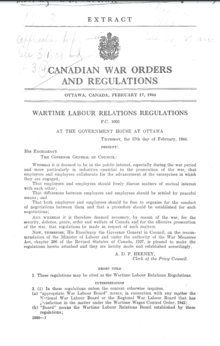Wartime Labour Relations Regulations
Drafted loosely on the American Wagner Act, it was the first federal legislation in Canada to legally protect the formation of unions and to force employers to negotiate with organized workers.
[6] As a result, 1940 saw the government make a declaration that employees should be free to join unions,[7] which was welcomed by organized labour leaders, but some shortcomings in behaviour by the Canada Board of Munitions and Supply led to the Canadian Congress of Labour to call for a Wagner-style law to be passed.
[8] In 1941, the Board of Conciliation under the Industrial Disputes Investigation Act, found that National Steel Car refused to allow unionization votes, identifying the lack of punitive measures in current regulations.
[9] In 1941, a cabinet shuffle moved McLarty to Secretary of State and Registrar General, and bringing in Humphrey Mitchell as the new Minister of Labour.
The province of Ontario introduced a collective bargaining act in 1943, that won acclaim from both labour and employers with regards to its ability to prevent work stoppages.
The report further called for the suspension of the Industrial Disputes Investigation Act for the duration of the war, and instead ban strikes and lockouts.
[14][15] The order's preamble highlighted the interest of the country's defense in mutual negotiations between labour and business.
[15] The Regulations included some issues not covered by the Wagner Act, such as assigning government responsibility to aid negotiations.
[17] A core mechanism of the order was to give an absolute right to all non-managerial workers in most sectors to be part of a trade union, protected workers from anti-union intimidation, protected the selection of union bargaining representatives, and establish a right to a bargaining process.
[22][23] Further criticism has been levied on the understanding that with this heavily legally protected position, unions became extremely bureaucratic and less radical.

